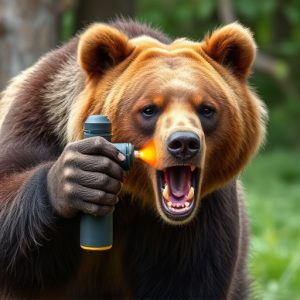Surviving Aggressive Bears: Strategies from Understanding Behavior to Effective Spray Use
Understanding bear behavior is crucial for safe exploration of wild environments. Maintaining a safe…….
Understanding bear behavior is crucial for safe exploration of wild environments. Maintaining a safe distance (at least 100 yards or 30 meters) and correct use of bear spray (effective up to 20-30 feet or 6-9 meters) are key strategies. If spray isn't available, alternative methods like appearing larger, making loud noises, and staying in groups can deter bears. Preparation, awareness, and regular education on bear behavior and the optimal distance for bear spray deployment significantly enhance safety in areas inhabited by bears.
“Venturing into bear country? Understanding aggressive bear behavior is your first line of defense. This comprehensive guide equips you with essential knowledge about navigating the wilderness safely. We explore key strategies, including the critical ‘optimal distance’ for effective use of bear spray, and delve into additional precautions beyond spray.
Learn how to choose and apply spray optimally, discover complementary safety measures, and gain insights on training for encounters with these powerful creatures. Prepare to confidently conquer your next outdoor adventure.”
- Understanding Bear Behavior: Key to Safety in the Wilderness
- The Role of Optimal Distance in Bear Deterrence with Spray
- Choosing and Applying Bear Spray Effectively
- Beyond Spray: Additional Measures for Aggressive Bear Encounters
- Training and Preparation: Ensuring Your Survival in Bear Country
Understanding Bear Behavior: Key to Safety in the Wilderness
Understanding bear behavior is a crucial aspect of staying safe in wild environments. Bears are typically shy and reclusive, preferring to avoid human interaction. However, their aggressive behavior can be triggered by several factors, such as protecting their young, defending food sources, or feeling threatened. Knowing these triggers can help hikers and outdoor enthusiasts minimize risks. One key strategy is maintaining the optimal distance for bear spray, which should be kept at a range where you can effectively deploy it without endangering yourself or the bear.
Bears have excellent senses of smell and hearing, so sudden movements and loud noises might startle them. Staying calm and avoiding direct eye contact, while making yourself appear larger by raising your arms, can deter an approaching bear from seeing you as a potential threat. By combining these behaviors with proper knowledge about local bear species and their habits, outdoor adventurers can significantly enhance their safety in bear country.
The Role of Optimal Distance in Bear Deterrence with Spray
Maintaining a safe distance from aggressive bears is paramount when venturing into their habitat. The optimal distance for bear spray use is a critical factor in deterring and, if necessary, defending against potential attacks. Experts recommend staying at least 100 yards (or approximately 30 meters) away from bears whenever possible. This distance ensures that the scent of the spray has enough time to reach the bear and potentially scare it away before becoming too close for comfort.
The effectiveness of bear spray is based on this calculated distance, allowing for a safe application without endangering yourself or the bear. It’s crucial to understand that proximity can significantly impact the outcome of an encounter. Staying within the recommended range enables you to use the spray effectively as a deterrent and, if the bear charges, gives you a chance to retreat while the spray takes effect.
Choosing and Applying Bear Spray Effectively
Choosing and applying bear spray effectively is a crucial component of outdoor safety in bear country. When selecting bear spray, look for products specifically designed for repelling bears, with an optimal distance range of 20-30 feet (6-9 meters). This range ensures that you can use the spray as a deterrent without putting yourself or others at risk of inhalation.
To apply bear spray effectively, hold the canister vertically and aim slightly below the bearing of the approaching bear. Spray in a sweeping motion, covering the bear from head to tail. It’s important to practice using bear spray before venturing into the wilderness to ensure you understand the proper technique. Remember, the key is to create a cloud of spray that obscures the bear’s senses and signals your intent to deter an attack.
Beyond Spray: Additional Measures for Aggressive Bear Encounters
When bear spray fails or isn’t an option, it’s crucial to have additional measures in place. Understanding the optimal distance for bear spray—typically around 20-30 feet (6-9 meters)—is a critical first step. However, knowing when and how to implement alternative strategies can make all the difference during an aggressive bear encounter.
One effective method is to make yourself appear larger by raising your arms or opening your jacket. Making loud noises, like shouting or banging objects, can also deter bears. If you’re with a group, stay close together and form a defensive posture. In extreme cases, playing dead might be recommended, but this should only be done as a last resort, ensuring the bear has lost interest before attempting to move or escape.
Training and Preparation: Ensuring Your Survival in Bear Country
In bear country, preparation and training are paramount to ensuring your safety. Knowing how to identify bear signs, understanding their behavior, and learning the optimal distance for deploying bear spray can make all the difference in a potentially life-threatening situation. Regularly attend workshops or take courses focused on bear awareness and survival skills specifically designed for outdoor enthusiasts and residents living in regions with high bear populations. These educational opportunities provide invaluable insights into avoiding encounters and responding appropriately if one does occur.
Moreover, familiarizing yourself with the recommended procedures for using bear spray is crucial. Practice deploying it at the proper distance—typically around 20-30 feet (6-9 meters)—to ensure its effectiveness. Keep in mind that bear spray is a tool of last resort; avoiding encounters through prevention measures like securing food properly and making noise while hiking should always be your primary focus.
Understanding bear behavior, knowing the optimal distance for bear spray usage, and taking proactive measures like training and preparation are essential components of outdoor safety in bear country. By combining these strategies with additional deterrents, you can significantly reduce risks during encounters with aggressive bears, enhancing your chances of survival and ensuring a more enjoyable wilderness experience.


